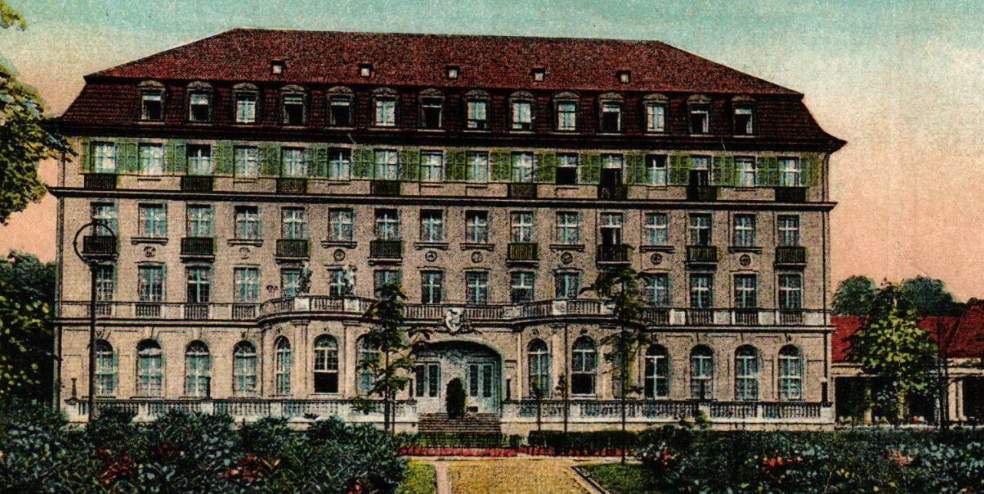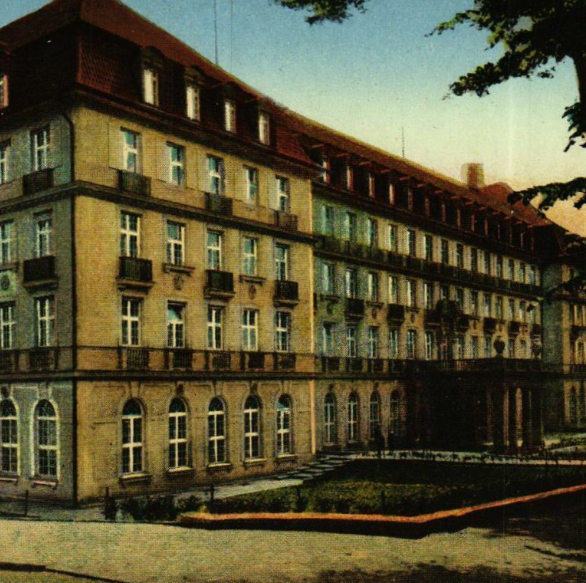Receive for Free - Discover & Explore eNewsletter monthly with advance notice of special offers, packages, and insider savings from 10% - 30% off Best Available Rates at selected hotels.
history
Discover the Parkhotel Quellenhof Aachen, which was originally founded to serve as the focal point to a wonderful spa complex.
Parkhotel Quellenhof Aachen, a member of Historic Hotels Worldwide since 2018, dates back to 1914.
VIEW TIMELINEIn the early 20th century, the City Council of Aachen decided to revive the community’s historic identity as a revered holiday destination. Its members specifically sought to resurrect the luxurious spa facilities that once defined the area for generations. After much deliberation, the council resolved to create a new entertainment district within a preexisting park known as the “Stadtgarten.” Anchoring this magnificent location would be an ornate hotel and spa that utilized water from the city’s underground thermal springs. The City Council of Aachen thus analyzed a variety of designs for the development of the prospective hotel complex starting in 1913. After several months, the council members eventually chose the blueprints submitted by Karl Stöhr and Theodor Fischer. Both men had designed a stunning four-story compound that faced the busy Monheimsallee highway. Three wings ran the length of the building, which was meant to house the entire spa and the hotel’s numerous upscale guestrooms. Gorgeous Neoclassical motifs constituted the structure’s overall appearance, such as a variety of symmetrically placed rectangular windows and a beautiful portico. The presence of classically inspired architecture continued inside the building, too, namely within the hotel’s main lobby. Grand columns extended high in the space to support a partially gilded stucco ceiling, while a balustraded staircase ascended to the floors above.
Construction began on the former site of the Stadtgarten’s vacated Maria Hilf Hospital a year later. However, the outbreak of World War I seriously undermined the project, as the conflict siphoned a significant number of resources. The City Council of Aachen nonetheless managed to keep the work going forward, with construction finally concluding in 1916. A grand opening then commenced that June, which formally opened the building as the “Palast-Hotel Quellenhof.” Many illustrious guests were in attendance, including the Prussian Minister of Agriculture, Clemens Freiherr von Schorlemer-Lieser. The hotel quickly developed a renowned reputation for its incredible services and unrivaled hospitality, especially once the fighting in Europe had stopped. The popularity of the business even enabled the hotel management team to expand upon the facilities considerably, culminating with the debut of a massive thermal swimming pool in 1936. (The largest structure of its kind in the world at the time, the pool was widely celebrated as an engineering marvel!) But this prosperity abruptly ended when World War II erupted not long thereafter. Largely escaping exposure to any kind of combat for months, the Palast-Hotel Quellenhof was finally caught in the crossfire during the Battle of Aachen in 1944. In fact, American soldiers had even stormed the facility to force out a German command post that had briefly established its headquarters on-site.
Heavily affected by the war, it took many years for the Palast-Hotel Quellenhof to recover. Operations gradually resumed though, beginning with the reopening of a mere four guestrooms. Architects continued to work throughout the building over the next two decades, eventually restoring the hotel back to its former glory in 1966. Now fully revitalized, the Palast-Hotel Quellenhof soon returned to being one of Aachen’s best destinations. But Aachen city officials decided to sell the historic hotel to the Kölner Fundus Gruppe in 1995, known currently as the “Jagdfeld Gruppe.” Investing some $50 million, the company proceeded to launch a two-year-long renovation that thoroughly preserved the building’s architectural integrity. Perhaps the greatest work the restoration accomplished was the refurbishment of the original stucco encasing the exterior façade. Then in 2020, Jagdfeld Gruppe decided to assume managerial responsibilities directly in order to better protect its heritage. The company began its own extensive renovation process, installing an upscale contemporary concept that infused modern hospitality standards within the building’s architectural integrity. Further renovations over the next three years transformed the on-site dining establishment into the luxurious culinary destination “Bistro,” while also creating a new series of suites throughout the third floor. Operating as the “Parkhotel Quellenhof Aachen” today, this fantastic historic hotel continues to enchant countless guests.
-
About the Location +
An incredibly historic city, Aachen is located in the state of North Rhine-Westphalia along Germany’s western border with both Belgium and the Netherlands. Its origins specifically harken back millennia to the height of the Roman Empire. Following Rome’s prolonged invasion of the region, the Romans had learned about the underground thermal springs that flowed through the site of modern-day Aachen. The emperor Hadrian subsequently ordered the construction of a sophisticated spa facility capable of tapping into the refreshing subterranean waters during the 2nd century A.D. Great channels soon fueled a variety of Roman bathhouses—known as thermae—which were part of two greater spa complexes. A bustling community formed around the facilities to help support their growth, too, which featured several notable structures like a forum and temple precinct. A tremendous collection of sprawling villas even dotted the surrounding countryside, giving Aachen a noticeable metropolitan atmosphere. However, the city’s significance decayed as Roman authority began to collapse throughout western Europe in the 4th century. In fact, Rome struggled to protect the region and eventually withdrew its troops. Most of Aachen’s spa facilities were then destroyed by hostile Germanic tribes, although the city itself managed to survive.
Aachen returned to cultural significance several centuries later amid the reign of the legendary Charlemagne. Through a combination of politicking and warfare, Charlemagne formed an imperial domain that covered large portions of Europe in the 8th century. (This civilization is remembered today as the Carolingian Empire.) He placed his main capital in Aachen during the 790s, having come to appreciate the city and its famous mineral springs. Charlamagne subsequently charged his entrusted architect Odo of Metz to develop a gorgeous compound called the “Palace of Aachen” near the wells. Odo in turn designed an interconnected series of religious, political, and residential structures that helped Charlemagne administrate his expansive fiefdom. Perhaps the most noteworthy building to appear within the Palace of Aachen was the beautiful Palatine Chapel. Situated toward the southern end of the complex, the chapel displayed gorgeous architectural elements like massive bronze doors, polychromatic stonework, and sprawling mosaics. However, Charlemagne also directed Odo to build a second church in the heart of Aachen, which eventually became known as the “Aachen Cathedral.” Designed to rival the Lateran Palace, the building emerged as the central spiritual institution throughout the entire realm. Charlemagne was even entombed inside the church upon his death in 814.
Aachen retained a great amount of political importance in the decades following Charlemagne’s reign, whose former kingdom had morphed into the Holy Roman Empire. In fact, more than 30 German monarchs were crowned inside Aachen Cathedral over the next seven centuries, starting with Otto I’s coronation in 936. Aachen specifically functioned as a free imperial city within the greater Holy Roman Empire, subject to only the dictates of the current emperor. But its proximity to Flanders made it an important economic center as well, leading to the emergence of a local publication industry that dominated the city for some time. However, Aachen began to experience a slow cultural decline upon the relocation of the imperial coronation site to Frankfurt in the early 1500s. Religious turmoil then erupted across the empire, as armies of Catholics and Protestants fought around Aachen throughout the following century. A massive fire even destroyed much of Aachen in 1656, forcing many of its inhabitants to slowly rebuild. Nevertheless, the city did retain some of its earlier relevance. For instance, Aachen became a favorite place for European diplomats to meet and discuss various treaties, including the intercontinental peace agreements that formally ended the War of Devolution (1668) and the War of the Austrian Succession (1748).
In 1794, General Charles François Dumouriez captured Aachen amid the French Revolutionary War. Aachen thus briefly became a territorial possession of France until it was granted to the newly created German Confederation after the Napoleonic Wars. The city then underwent a rapid period of industrialization in the wake of the conflict, with its factories manufacturing distinctive goods like carriages, buttons, and train cars. This economic activity made Aachen among the most productive cities in the German Confederation, which turned into the nation-state of Germany in the late 19th century. Nevertheless, Aachen’s newfound prosperity experienced periodic instability in the first half of the 20th century, especially during both World Wars. In fact, Aachen itself became a battleground when German and American armies clashed inside the city for several days in the autumn of 1944. In the years since Germany’s reunification, the metropolis has reemerged as one of the most influential in the country. Indeed, it is a prominent center for German higher education, as well as technological development. It is also an adored cultural heritage destination, offering access to a variety of fascinating historical landmarks. Perhaps its most noteworthy is the Aachen Cathedral, which the United Nations designated as a UNESCO World Heritage Site in 1978.
-
About the Architecture +
When German architects Karl Stöhr and Theodor Fischer designed the Parkhotel Quellenhof Aachen, they specifically chose Classical Revival style as the main source of their inspiration. Also known as “Neoclassical,” Classical Revival architecture itself is among the most common architectural forms seen throughout the world today. This wonderful architectural style first became popular in Paris, specifically among French architectural students that studied in Rome in the late 18th century. Upon their return, the architects began emulating aspects of earlier Baroque design aesthetics into their designs, before finally settling on Greco-Roman examples. Over time, the embrace of Greco-Roman architectural themes spread across the world, reaching destinations like Germany, Spain, and Great Britain. As with the equally popular Revivalist styles of the same period, Classical Revival architect found an audience for its more formal nature. It specifically relied on stylistic design elements that incorporated such structural components, like the symmetrical placement of doors and windows, as well as a front porch crowned with a classical pediment. Architects would also install a rounded front portico that possessed a balustraded flat roof. Pilasters and other sculptured ornamentations proliferated throughout the façade of the building, as well. Perhaps the most striking feature of buildings designed with Classical Revival-style architecture were massive columns that displayed some combination of Corinthian, Doric, or Ionic capitals. With its Greco-Roman temple-like form, Classical Revival-style architecture was considered most appropriate for municipal buildings like courthouses, libraries, and schools. But the form found its way into more commercial uses over time, such as banks, department stores, and of course, hotels. Architects still rely on Classic Revival architecture when designing new buildings or renovating historic ones, making it among the most ubiquitous architectural styles in the world.
-
Famous Historic Guests +
Winston Churchill, Prime Minister of the United Kingdom (1940 – 1945; 1951 – 1955)
Prince Bernhard of the Netherlands (1948 – 1980)
Queen Beatrix of the Netherlands (1980 – 2013)
King Juan Carols I of Spain (1975 – 2014)































